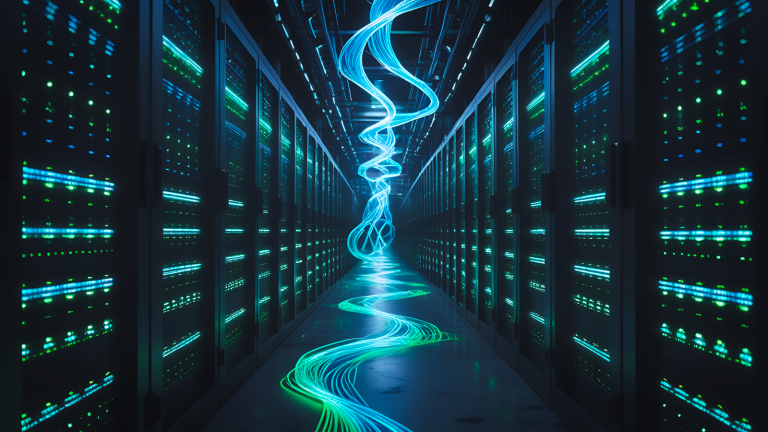Editor’s note: “AI’s Achilles’ Heel Just Became a $50 Billion Opportunity” was previously published in October 2025 with the title, “The Coming AI Energy Crunch – and the $50-Billion Opportunity No One Sees Yet.” It has since been updated to include the most relevant information available.
Wall Street is obsessing over the wrong layer of the AI stack.
While everyone chases chips and cloud stocks, a $50-plus billion infrastructure buildout is unfolding beneath the surface – and most investors have no idea it’s happening.
AI data centers need power that’s not just abundant… it needs to be always on. According to Morgan Stanley, U.S. data centers are racing toward a 36 GW power shortfall.
We’re calling it The Crunch: the moment when the AI Boom hits the limits of America’s power grid.
We’ve talked about how small modular reactors (SMRs) and microreactors could fill the gap in primary generation, creating a huge investment opportunity in nuclear energy stocks.
But solving The Crunch isn’t just about generating more power. It’s also about making sure that power is always available.
That’s where energy storage comes in – and why this “second layer” could be the next huge wave of AI-driven investment…
Why AI Data Centers Are Creating a Global Energy Storage Boom
AI data centers aren’t like traditional facilities.
They’re energy-dense, continuously operating GPU ‘farms’ that train and serve large models around the clock. Because these systems handle massive amounts of computation and depend on constant power and cooling, even brief interruptions can halt training runs, corrupt workloads, or delay production schedules – costing operators significant time and money.
Historically, data centers relied on diesel generators for backup – dirty, noisy, carbon-intensive, but effective.
But that’s no longer good enough. Hyperscalers – like Microsoft (MSFT), Alphabet (GOOGL), Amazon (AMZN), and Meta (META) – are under intense pressure to ditch diesel and move to clean, modern, always-on solutions.
That’s why a new consensus is emerging: every AI data center should pair its grid power with onsite energy storage.
So, SMRs, gas, and renewables will keep the lights on, while batteries and fuel cells will keep things running even if the grid hiccups.
It’s a two-front energy war – power generation and reliability. And Wall Street hasn’t priced in the second front yet…
Inside the New Power Stack: Batteries, Fuel Cells, and Microgrids
What does this storage layer actually look like? Three technologies are leading the race:
1. Battery Energy Storage Systems (BESS)
- Lithium-ion: Fast response (<1 second) and high round-trip efficiency (90%-plus), making it ideal for short interruptions or frequency regulation. Used by hyperscalers for momentary grid support and smooth transfer to generators.
- Next-gen chemistries (zinc, flow batteries): These systems trade energy density for longevity and cost stability, enabling backup over multi-hour to multi-day windows.
- Flow batteries (vanadium or iron-based) can cycle thousands of times without degradation – key for data centers with 24/7 AI training loads.
- Zinc hybrid cathode systems are being tested for eight- to 24-hour resilience at data center scale.
- Key advantage: Can be integrated seamlessly with renewable power purchase agreements (PPAs).
2. Fuel Cells
- Solid Oxide Fuel Cells (SOFCs) – High-efficiency systems (up to 65%) that convert fuels such as natural gas, biogas, or hydrogen into electricity and heat via an electrochemical process; no combustion, minimal emissions.
- PEM & Other Designs (Proton Exchange Membrane, Molten Carbonate) – Faster-start variants suited for distributed backup. Some models integrate with green hydrogen systems, offering zero-carbon backup potential.
- Key advantage: Longer duration resilience than batteries, cleaner than diesel.
3. Hybrid Microgrids
- A hybrid microgrid stitches together renewables + BESS + fuel cells (and sometimes SMRs or gas) into a cohesive onsite ecosystem.
- Smart controllers balance instantaneous power needs: BESS for fast transitions, fuel cells for sustained output, renewables for long-term cost offset.
- Hyperscalers love this approach because it hits uptime, ESG, and cost-optimization all at once.
Big Tech’s Billion-Dollar Energy Deals Prove the Shift Is Underway
Importantly, deals in this space are already happening – and they’re scaling fast.
Fuel Cell Deals Already Leading the Way
- Bloom Energy (BE) + Brookfield (BN): A $5 billion partnership to make Bloom the “preferred onsite power provider” for Brookfield’s global AI data center buildout.
- Bloom Energy + Oracle (ORCL): Fuel cells to power Oracle Cloud data centers, with some deployments ready in just 90 days.
- Bloom Energy + Equinix (EQIX): Expanding fuel cell deployment across 19 data centers, targeting over 100 MW.
- Bloom Energy + American Electric Power (AEP): Agreement for up to 1 GW of fuel cell power capacity for AI data centers and off-grid use.
- FuelCell Energy (FCEL) + Inuverse: 100 MW fuel cell deployment for an AI data center in Korea.
Battery/BESS Deals – Earlier Stage But Emerging
- Amazon + AES (AES): 450 MW solar project with associated batteries, explicitly linked to powering data centers.
- Caterpillar (CAT) + Joule Capital: >1 GWh battery system deployed alongside CHP at a Utah datacenter campus.
- GridStor (Oklahoma): 200 MW/800 MWh battery project positioned specifically to support data center growth zones.
- Fluence (FLNC) + Excelsior: 2.2 GWh of Gridstack Pro batteries deployed in the U.S., targeting resiliency for power-intensive sites.
These deals make two things clear:
- Fuel cells are out front because they can be deployed fast, cleanly, and at scale.
- Batteries are catching up as costs fall and hyperscalers look for integrated renewable + storage packages.
Sizing the AI Energy Opportunity
Let’s size this.
Global AI data center power demand is projected to grow by roughly 57 GW by 2028, according to the International Energy Agency and UBS Research. If even half of that load requires onsite backup, that’s 25 to 30 GW of new storage capacity over just three years.
At today’s costs – about $500- to $700,000 per MW for battery energy-storage systems (BESS) and $1- to $1.5 million per MW for fuel-cell installations – that translates to $20- to $30 billion in incremental total addressable market (TAM), on top of what utilities and renewable developers are already building.
Add the rest of the world’s data center buildout –from Asia’s hyperscaler campuses to Europe’s cloud clusters – and the figure likely doubles past $50 billion.
This isn’t a niche market. It’s becoming a core pillar of the AI economy.
Here’s where investors should look to capitalize:
Fuel Cell Leaders
- Bloom Energy – Market leader with multi-MW deployments at Oracle, Equinix, and Brookfield sites. Bloom’s solid-oxide systems run on natural gas or hydrogen, offering 24/7 onsite generation.
- FuelCell Energy – Smaller player expanding internationally (notably in Korea). Its molten-carbonate technology targets utility and campus-scale backup.
- Plug Power (PLUG) – Financially stretched but owns hydrogen-generation and PEM fuel-cell tech suited for modular data center nodes. A speculative long shot.
Battery Storage Players
- Fluence Energy – Global utility-scale integrator; booking 1 GWh-plus contracts with cloud providers and grid operators.
- Eos Energy (EOSE) – Commercializing zinc-hybrid cathode batteries for long-duration storage (8–24 hr). High risk, high reward.
- Stem (STEM) – Provides AI-driven software that optimizes battery dispatch and grid participation, layering intelligence on top of physical assets.
- Tesla Energy (TSLA) – A quiet giant. Its Megapack units already dominate grid storage (>50 GWh installed globally), and Tesla is courting data center clients directly.
Industrial/Hybrid Power Integrators
- Caterpillar (CAT) – From diesel gensets to hybrid battery systems, Cat retains a deep footprint in data center backup and is pivoting toward cleaner microgrids.
- Honeywell (HON) – Developing modular battery + microgrid platforms for critical infrastructure; recently partnered with ESS Inc. on long-duration flow systems.
Can Battery and Fuel Cell Firms Deliver?
Of course, as with any new technology, there are risks and challenges to the AI data center energy storage buildout.
On the tech side, batteries are excellent for short-duration outages, though limited for multi-day resilience. Fuel cells are better here, but they also depend on natural gas or hydrogen supply chains.
Meanwhile, execution will prove daunting. Bloom Energy and Plug Power have historically struggled with margins and profitability. Scaling into multi-GW deployments is not trivial. Bloom is showing some traction here. Plug… not so much. Executors will differentiate themselves and turn into the real winners.
And, of course, traditional diesel isn’t dead yet. It’s cheap, well-understood, and entrenched. And hydrogen fuel supply chains still face regulatory gaps. Not to mention, battery deployments must address fire safety, siting, and recycling.
So, yes, risks and challenges remain. But the trajectory toward potentially massive gains in the energy storage sector is becoming clearer with the ever-growing need for onsite backup power for energy-hungry AI data centers.
Why the AI Energy Trade Is Heating Up Right Now
When it comes to investing, timing is everything. And the timing for this AI energy storage trade couldn’t be better…
AI workloads are exploding. Training large language models has turned into a 24/7 industrial grind: a nonstop race where a single hiccup can derail days of progress and torch millions in compute costs.
At the same time, hyperscalers are ditching diesel. The old backup systems that kept the internet alive for decades are suddenly out of step with our new reality. ESG mandates, shareholder pressure, and customer optics are forcing the big players to clean up their power stacks. They need solutions that are both reliable and green.
And those solutions are already hitting the field. Brookfield’s $5 billion CoreWeave partnership, Amazon’s growing web of solar-plus-storage PPAs, Microsoft quietly rolling out onsite fuel cells at its campuses… These are the early innings of a full-scale energy transition, built around the world’s most demanding workloads.
Meanwhile, Wall Street’s still asleep at the wheel. Investors are treating batteries and fuel cells like some clean-tech sideshow. They’re not seeing what’s right in front of them: these systems are core AI infrastructure.
That’s the blind spot – and the opportunity.
The AI Power Revolution Is Here – and Energy Storage Is Its Foundation
The Crunch isn’t just about producing more power. It’s about guaranteeing that power is always there, always stable, and always clean.
That’s what makes batteries and fuel cells the unsung heroes of the AI revolution. They’re not the headline names like Nvidia (NVDA) or Microsoft or Oklo. But they’re the foundation under them – the layer that makes the whole system work.
The list of potential winners is clear: Bloom Energy, FuelCell, Fluence Energy, Eos, Stem, Tesla, Caterpillar, Honeywell.
If AI is the new electricity, then these are the safety belts and airbags keeping it alive. No hyperscale campus gets built without them.
And as this next wave of AI infrastructure unfolds, the ‘storage trade’ could become the market’s next megatrend, right alongside chips and reactors.
Because The Crunch isn’t just about watts. It’s about resilience. And the companies that deliver that resilience will be the hidden giants of the AI economy.
Over the past several months, the federal government has taken equity stakes in a slew of companies it’s deemed critical to securing America’s AI dominance – MP Materials (MP), Lithium Americas (LAC), Trilogy Metals (TMQ)… all of which surged in the weeks following those investments.
Now it has its sights set on the nuclear sector. And I’ve identified one unusual yet politically well-connected energy stock that could be next in line for a federal cash injection.


